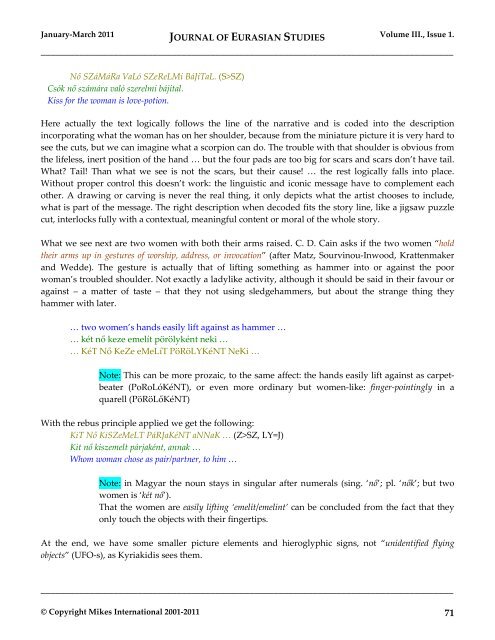JOURNAL OF EURASIAN STUDIES
JOURNAL OF EURASIAN STUDIES
JOURNAL OF EURASIAN STUDIES
Create successful ePaper yourself
Turn your PDF publications into a flip-book with our unique Google optimized e-Paper software.
January-March 2011 <strong>JOURNAL</strong> <strong>OF</strong> <strong>EURASIAN</strong> <strong>STUDIES</strong> Volume III., Issue 1.<br />
_____________________________________________________________________________________<br />
Nő SZáMáRa VaLó SZeReLMi BáJiTaL. (S>SZ)<br />
Csók nő számára való szerelmi bájital.<br />
Kiss for the woman is love-potion.<br />
Here actually the text logically follows the line of the narrative and is coded into the description<br />
incorporating what the woman has on her shoulder, because from the miniature picture it is very hard to<br />
see the cuts, but we can imagine what a scorpion can do. The trouble with that shoulder is obvious from<br />
the lifeless, inert position of the hand … but the four pads are too big for scars and scars don’t have tail.<br />
What? Tail! Than what we see is not the scars, but their cause! … the rest logically falls into place.<br />
Without proper control this doesn’t work: the linguistic and iconic message have to complement each<br />
other. A drawing or carving is never the real thing, it only depicts what the artist chooses to include,<br />
what is part of the message. The right description when decoded fits the story line, like a jigsaw puzzle<br />
cut, interlocks fully with a contextual, meaningful content or moral of the whole story.<br />
What we see next are two women with both their arms raised. C. D. Cain asks if the two women “hold<br />
their arms up in gestures of worship, address, or invocation” (after Matz, Sourvinou-Inwood, Krattenmaker<br />
and Wedde). The gesture is actually that of lifting something as hammer into or against the poor<br />
woman’s troubled shoulder. Not exactly a ladylike activity, although it should be said in their favour or<br />
against – a matter of taste – that they not using sledgehammers, but about the strange thing they<br />
hammer with later.<br />
… two women’s hands easily lift against as hammer …<br />
… két nő keze emelít pörölyként neki …<br />
… KéT Nő KeZe eMeLíT PöRöLYKéNT NeKi …<br />
Note: This can be more prozaic, to the same affect: the hands easily lift against as carpetbeater<br />
(PoRoLóKéNT), or even more ordinary but women-like: finger-pointingly in a<br />
quarell (PöRöLőKéNT)<br />
With the rebus principle applied we get the following:<br />
KiT Nő KiSZeMeLT PáRJaKéNT aNNaK … (Z>SZ, LY=J)<br />
Kit nő kiszemelt párjaként, annak …<br />
Whom woman chose as pair/partner, to him …<br />
Note: in Magyar the noun stays in singular after numerals (sing. ‘nő’; pl. ‘nők’; but two<br />
women is ‘két nő’).<br />
That the women are easily lifting ‘emelít/emelint’ can be concluded from the fact that they<br />
only touch the objects with their fingertips.<br />
At the end, we have some smaller picture elements and hieroglyphic signs, not “unidentified flying<br />
objects” (UFO-s), as Kyriakidis sees them.<br />
_____________________________________________________________________________________<br />
© Copyright Mikes International 2001-2011 71

















